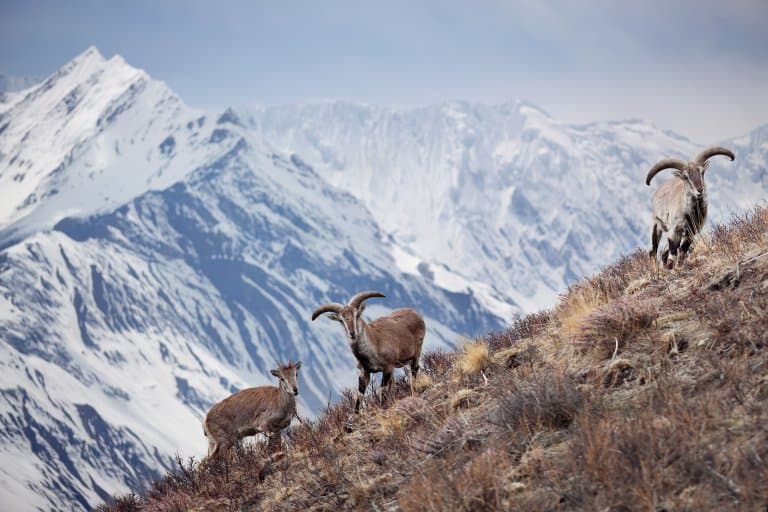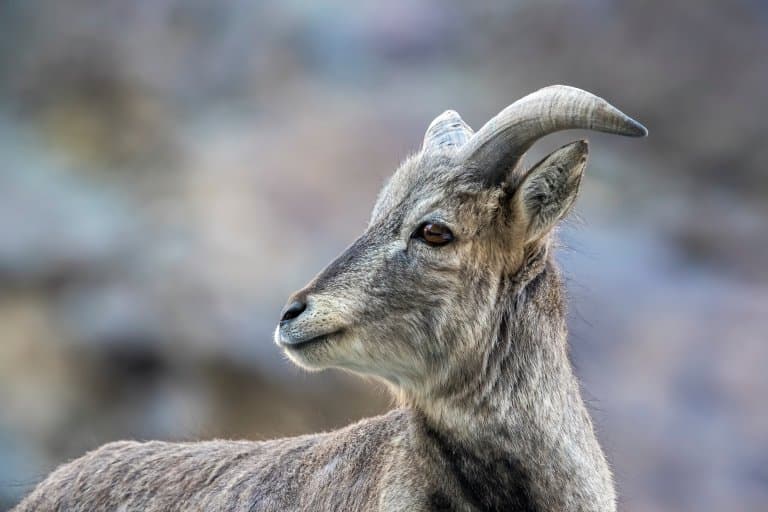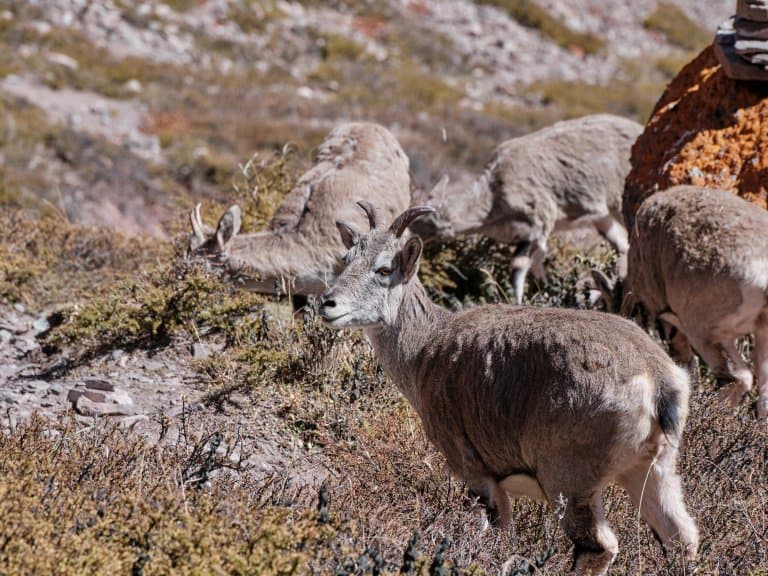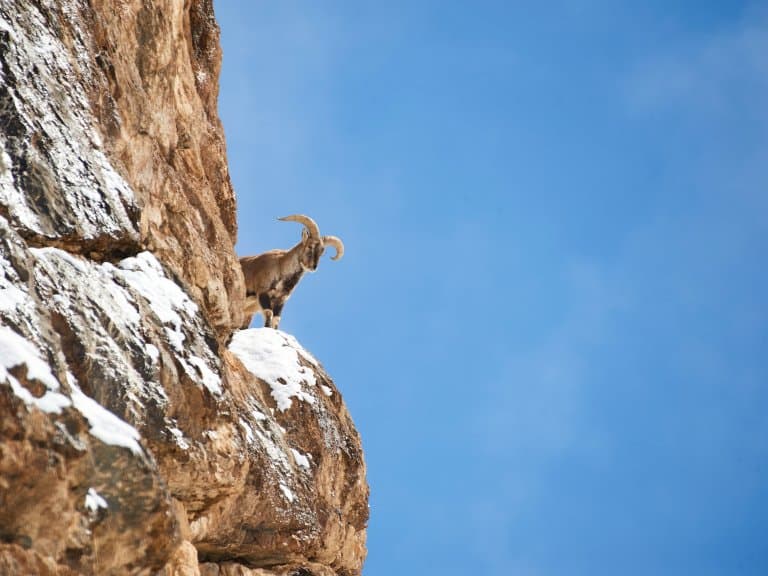Bharal Profile
Himalayan mammals are tough customers. They live in places we typically can’t get to, and this creates as many problems as it solves.
Bharals are a wild species of sheep that we find particularly uncomfortable to monitor on account of them hanging out at altitudes where we find it hard to breathe.

Bharal Facts Overview
| Habitat: | Steep mountainous terrain at high altitude |
| Location: | Himalayas: India, Bhutan, China, Myanmar, Nepal, Pakistan |
| Lifespan: | Unknown |
| Size: | 91cm (36 inches) tall |
| Weight: | Up to 75kg (165lb) |
| Colour: | Grey-brown with creamy white underbelly |
| Diet: | Herbs, lichens, mosses, grasses and shrubs |
| Predators: | Leopards, wolves, foxes, eagles |
| Top Speed: | Unknown |
| No. of Species: | 1 |
| Conservation Status: | Least Concern (IUCN) |
Bharals are impressive, well-adapted mountain warriors. They have special blood and coats to handle a wide range of weather and rarely venture lower down the mountains than 2,500 meters.
Their inhospitable environment helps keep them out of humans’ way but also makes it difficult to assess the damage livestock are going to do to their numbers.
Right now, they seem to be doing well though, and their protection even helps some of the most popular animals out, too.
Interesting Bharal Facts
1. Blue sheep
This mountain specialist is also known by several different names. In Urdu, the name Bharal means ‘wild sheep’, which is pretty much exactly what it is.
But it’s also known as the Great Blue Sheep, which is somewhat more debatable, as it’s a remarkably grey animal in most cases.
Its coat has a thick, dense fur that holds onto color much like the underside of a thundercloud, and this, on occasion, is what leads it to have a slightly blue hue.
Unfortunately, as wild sheep, bharal aren’t milked, but even if they were, it wouldn’t be possible to get blue cheese out of them.
One of the reasons they’re not milked, presumably, is due to how hard they are to get to.

2. They live very high up
This might be a bit of an understatement, as they live on the tallest mountain range there is. Still, they don’t make it all the way to the top.
Bharals spend a lot of their time at altitudes of around 5,500 meters, which is exceptionally high. They rarely, if ever, dip below 2,500 meters, instead preferring to stay out of harm’s reach, across a diverse range of high-altitude habitats.
These could be rocky outcrops or grassy planes or slopes. They’re competent on cliffs, and usually stay somewhere they can quickly take cover at the sight of a predator.
They prefer open spaces to forests, but in general, the inhospitable landscapes they choose allow them more or less a monopoly on all the good food. 1
3. They can handle the heat
Some animals are just tough. While many mammals adapted to cold temperatures are too fluffy or fatty to handle the heat, Bharals can swing both ways with ease.
They’re just as comfortable on steep desert mountains in high temperatures as they are on windy, cold slopes.
Some researchers have tried to figure out how they handle these extremes by putting some into a climatic chamber, which simulates high-altitude conditions.
They found that the blue sheep are more comfortable and capable of low oxygen consumption than animals adapted for lower altitudes and that their hearts don’t appear to need as much adjustment when going from low altitude to high.
Some of these adaptations were seen also in the Pika (and ili pika), another mountain mammal, and are a sign that the Bharal is fully adapted to its mountain life, to the point where it may not be well equipped to live at low altitudes. 2

4. They avoid humans pretty well
Competition with livestock is common in the mountains. People often take their sheep up there and have them potter about, and they eat all the good stuff, and sometimes outcompete the native fauna.
Or sometimes, the native fauna eats all the good stuff and the farmers go out and kill them.
This is theorised to be an issue with Bharal, but it’s very cold and rocky all the way up there, so it’s quite hard to go up and check.
Luckily, livestock and farmers also don’t prefer to be that cold and high up either, and so Bharal can stay at elevations that livestock can’t, which gives them a lot of protection.
Even in select regions where there’s significant overlap, it seems like livestock presence doesn’t affect the Bharal’s ability to thrive, even while lesser mammals struggle.
5. Some of them are Dwarves
It was once thought that there was a second species of Bharal: a tiny version of the Blue sheep, known for a while as Pseudois schaeferi.
This was designated a new species in 1978, as an animal that was clearly related to P. nayaur, yet much, much smaller. Known commonly as the dwarf blue sheep, these weigh around half that of the larger variety and are around 10cm shorter.
This makes them a very slender version of the blue sheep, and until recently, were considered to be a different species. In 2000, an assessment suggested there were only 200 of this species left, and listed them as Endangered.
While it’s still a matter of the confusion and speculation ubiquitous in taxonomy, it’s now much more likely that the Dwarf blue sheep is at least the same species as P. nayaur and maybe even the same subspecies.
So, it’s just a tiny Bharal. 3
6. But the Dwarves are less protected
Dwarf blue sheep are skittish and nimble, and it bears repeating that they live bloody high up, so the literature on them leaves a lot to be desired.
It appears that they’re morning animals, occupying small herds of up to 15, but usually closer to five, of all ages and sexes.
They’re commonly predated upon by wolves and leopards, and despite being the same species as the larger cousin, they are a threatened population.
Luckily, much of their range overlaps with protected reserves, but poaching and illegal habitat destruction is still an issue.
7. Livestock competition will likely be a growing problem
While the presence of livestock doesn’t prevent Bharal from thriving, the growing nature of its presence might.
It’s been shown that there’s a high overlap in diet between the wild sheep and the domesticated ones, and livestock greatly reduces a lot of the Bharal’s favourite foods. Bharal density was shown to be 63% lower in intensively grazed rangeland, and that does suggest competition.
Essentially, as livestock density increases, Bharal density drops. This doesn’t bode well for the future, since meat consumption is on the rise almost everywhere.
Further, the length of time that livestock has been grazed in an area also contributes. In some regions, the soil is depleted from intensive grazing and supplemental feeding for centuries, and this has had a significant impact on the biomass of the plants Bharals eat.

8. But they’re good at what they do
Bharals switch effortlessly between grazing and browsing: two forms of nibbling away at plants that are commonly not both found in a single herbivore.
As the grazing options decline with increasing livestock densities, Bharals start browsing instead, eating from plants and shrubs that are off the ground.
This is a remarkable sign of resilience, but it’s far from ideal. Conservationists are suggesting that there need to be more livestock-free areas for their, and other grazing species’ protection.
9. They may be the key to Snow Leopard conservation
One high-profile species may owe its life to the protection of the Bharal. The snow leopard loves a bit of Bharal for breakfast, and increasing the abundance of the herbivore has been hypothesised to positively impact the number of leopards.
In one reserve, Bharal numbers increased by four times. This level plateaued as the carrying capacity of the area was reached, and based on previous examples and plenty of research evidence, The Snow Leopard Trust thinks this will lead to more leopards.
Unfortunately, snow leopards are even harder to monitor than Bharals. 4
10. They can jump 2m in height!
Because they live in a mountainous terrain with steep cliffs, they’re no stranger to going airborne when travelling between mountain peaks and passes, and escaping predators.
Bharal are extremely quick and agile, and are capable of climbing steep rocky mountain ridges.
In fact, the bharal can reach amazing heights jumping over 2 m (6.5 ft) in height and made our top 10 highest jumping animals in the world list.
Bharal Fact-File Summary
Scientific Classification
| Kingdom: | Animalia |
| Phylum: | Chordata |
| Class: | Mammalia |
| Order: | Artiodactyla |
| Family: | Bovidae |
| Subfamily: | Caprinae |
| Tribe: | Caprini |
| Genus: | Pseudois |
| Species: | Pseudois Nayaur |
Fact Sources & References
- “Blue Sheep”, IUCN.
- Akio Sakai (2003), “Cardiopulmonary Hemodynamics of Blue-Sheep, Pseudois nayaur, as High-Altitude Adapted Mammals”, J-Stage.
- “Pseudois schaeferi”, Ultimate Ungulate.
- Matt Fiechter (2016), “Wild Snow Leopard Prey Recovers Thanks to Reserve”, Snow Leopard Trust.
